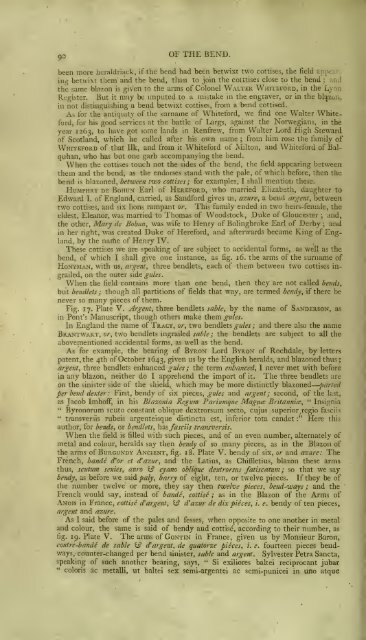A System of Heraldry - Clan Strachan Society
A System of Heraldry - Clan Strachan Society
A System of Heraldry - Clan Strachan Society
You also want an ePaper? Increase the reach of your titles
YUMPU automatically turns print PDFs into web optimized ePapers that Google loves.
9 o<br />
OF THE BEND.<br />
been more heraldriack, if the bend had been betwixt two cottises, the field apr<br />
ing betuixt them and the bend, than to join the cotttises close to the benu<br />
the same blazon is given to the arms <strong>of</strong> Colonel WALTER WIUTEFORD, in the Lyon<br />
Register. But it may be imputed to a mistake in the engraver, or in the bla;/.<br />
in not distinguishing a bend betwixt cottises, from a bend cottised.<br />
As for the antiquity <strong>of</strong> the surname <strong>of</strong> Whiteford, we find one Walter Whiteford,<br />
for his good services at the battle <strong>of</strong> Largs, against the Norwegians, in the<br />
year 1263, to have got some lands in Renfrew, from Walter Lord High Steward<br />
<strong>of</strong> Scotland, which he called after his own name ; from him rose the family <strong>of</strong><br />
WHITEFORD <strong>of</strong> that Ilk, and from it Whiteford <strong>of</strong> Milton, and Whiteford <strong>of</strong> Balquhan,<br />
who has but one garb accompanying the bend.<br />
When the cottises touch not the sides <strong>of</strong> the bend, the field appearing between<br />
them and the bend, as the endorses stand with the pale, <strong>of</strong> which before, then the<br />
bend is blazoned, between two cottises ; for examples, I shall mention these.<br />
HUMPHRY DE BOHUN Earl <strong>of</strong> HEREFORD, who married Elizabeth, daughter to<br />
Edward I. <strong>of</strong> England, carried, as Sandford gives us, azure, a bend argent, between<br />
two cottises, and six lions rampant or. This family ended in two heirs-female, the<br />
eldest, Eleanor, was married to Thomas <strong>of</strong> Woodstock, Duke <strong>of</strong> Gloucester ; and,<br />
the other, Mary de Bohun, was wife to Henry <strong>of</strong> Bolingbroke Earl <strong>of</strong> Derby ; and<br />
in her right, was created Duke <strong>of</strong> Hereford, and afterwards became King <strong>of</strong> England,<br />
by the name <strong>of</strong> Henry IV.<br />
These cottises we are speaking <strong>of</strong> are subject to accidental forms, as well as the<br />
bend, <strong>of</strong> which I shall give one instance, as fig. 16. the arms <strong>of</strong> the surname <strong>of</strong><br />
HONYMAN, with us, argent, three bendlets, each <strong>of</strong> them between two cottises in-<br />
grailed, on the outer side gules.<br />
When the field contains more than one bend, then they are not called bends,<br />
but bendlets; though all partitions <strong>of</strong> fields that way, are termed bendy,<br />
if there be<br />
never so many pieces <strong>of</strong> them.<br />
Fig. 17. Plate V. Argent, three bendlets sable, by the name <strong>of</strong> SANDERSON, as<br />
in Font's Manuscript, though others make them gules.<br />
In England the name <strong>of</strong> TRACY, or, two bendlets gules ; and there also the name<br />
BRANTWART, or, two bendlets ingrailed sable ; the bendlets are subject to all the<br />
abovementioned accidental forms, as well as the bend.<br />
As for example, the bearing <strong>of</strong> BYRON Lord BYRON <strong>of</strong> Rochdale, by letters<br />
patent, the 4th <strong>of</strong> October 1643, given us by the English heralds, and blazoned thus ;<br />
argent, three bendlets enhanced gules; the term enhanced, I never met with before<br />
in any blazon, neither do I apprehend the import <strong>of</strong> it. The three bendlets are<br />
on the sinister side <strong>of</strong> the shield, which may be more distinctly blazoned parted<br />
per bend dexter: First, bendy <strong>of</strong> six pieces, gules and argent; second, <strong>of</strong> the last,<br />
as Jacob Imh<strong>of</strong>f, in his Blazonia Regum Pariumque Magnte Britannia, " Insignia<br />
" Byronorum scuto constant oblique dextrorsum secto, cujus superior ( regio fasciis<br />
" transversis rubeis argenteisque distincta est, inferior tota candet :" Here this<br />
author, for bends, or bendlets, has fasciis transversis.<br />
When the field is filled with such pieces, and <strong>of</strong> an even number, alternately <strong>of</strong><br />
metal and colour, heralds say then bendy<br />
<strong>of</strong> so many pieces, as in the Blazon <strong>of</strong><br />
the arms <strong>of</strong> BURGUNDY ANCIENT, fig. 18. Plate V. bendy <strong>of</strong> six, or and azure: The<br />
French, bande d'or et d'azur, and the Latins, as Chiffletius, blazon these arms<br />
thus, scutum sexies, auro y cyano oblique dextrorsus fatiscatum; so that we say<br />
bendy, as before we said paly, barry <strong>of</strong> eight, ten, or twelve pieces. If they be <strong>of</strong><br />
the number twelve or more, they say then twelve pieces, bend-ways ; and the<br />
French would say, instead <strong>of</strong> bande, cottise ; as in the Blazon <strong>of</strong> the Arms <strong>of</strong><br />
1<br />
ANOIS in France, cottise d argent, y d'azur de dix i. e. pieces, bendy <strong>of</strong> ten pieces,<br />
argent and azure.<br />
As I said before <strong>of</strong> the pales and fesses, when opposite to one another in metal<br />
and colour, the same is said <strong>of</strong> bendy and cottise, according to their number, as<br />
fig. 19. Plate V. The arms <strong>of</strong> GONTIN in France, given us by Monsieur Baron,<br />
contre-bande de sable & d 'argent, de quatorze pieces, i. e. fourteen pieces bend-<br />
ways, counter-changed per bend sinister, sable and argent. Sylvester Petra Sancta,<br />
speaking <strong>of</strong> such another bearing, says, " Si exiliores baltei reciprocant jubar<br />
" coloris ac metalli, ut baltei sex semi-argentei ac semi-punicei in uno atque




